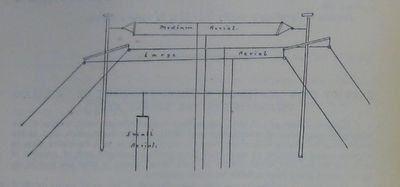German Wireless Systems
British mention of German wireless signaling often uses the German word Telefunken.
1907
The Germans apparently started off a bit slower than the British. The Royal Navy received a report from Lieutenant N. Usborne on German use of W/T, and published an extract in the Annual Report of the Torpedo School, 1907.[1]
Training
Usborne noted that the equipment was manufactured to a finish of "wonderful elegance", but that the state of training of personnel was abysmal: the Executive Lieutenant in charge having received a mere two-weeks' [italics used in the source] course being in charge of the installation. The Engineer Officer had received no more training, and sometimes none at all. The Executive Officer was in charge of wireless signals.
When a watch was being kept, two men were always assigned. This meant eight being required for round-the-clock coverage, and these numbers were provided or exceeded, with Königsberg of 3,200 tons relying on eleven men: 3 P.O.s, 1 signalman, four stokers, and three blue jackets. These men received a little more training (up to two months) in Morse and were suitable signalmen with a casual knowledge of the equipment though scarcely acquainted with what the various boxes contained.
Usborne noted that none of the three Wireless Officers in Königsberg, Hohenzollern or Scharnhorst knew the unit of inductance. It was noted that the Germans intended to ramp up training to ensure that officers knew more than their charges.
Tunes and Aerials

They were observed using four wavelengths over three aerials as shown in the figure:
- short wave for fleet signalling at 150 metres wavelength, using a small vertical aerial
- "N.W." wave for international signalling at 350 metres, using a medium aerial
- "G" wave at 550 metres, ditto
- "D" wave at 780 metres, using a large aerial
Usborne was impressed with the use of standard equipment despite differences in ships. This has always been a weak point for the British! The short wave using the small aerial was a different transmitter about 2/3rds the size of that used for the other three wavelengths.[3]
1909[4]
The Germans were now a continual voice on the airwaves, especially on "V" and "W", at 30 cycles and no "note".
They used numeric call signs, used the sign "KK" as the British used "G", and acknowledged messages by making their own call sign.
Groups generally had 3 or 4 characters, and each 4 character group was noticed to begin with "Ñ" (— — • — —). P, U and R are noted as being used singly, and P seemed to indicate a full stop.
The "III" sign was used between groups, and each group was made 2-3 times rather than repeating the message itself as was the British practice. Messages end with DD, DDD or HHH.
See Also
Footnotes
Bibliography